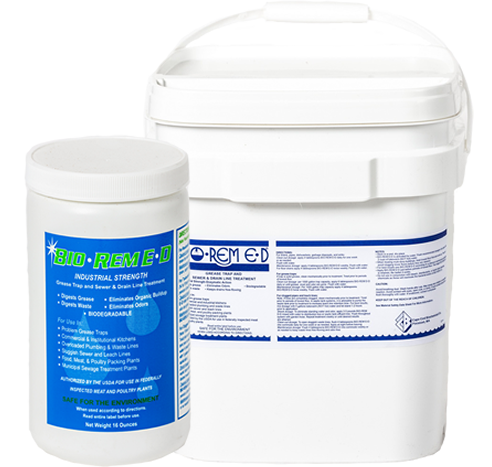Cape Cod Biochemical Company and Septic Contractors, Partners Since 1976

BIO-REM E-D Grease Trap and Sewer & Drain Line Treatment
USES:
ADVANTAGES:
-
Provides fast digestive action with immediately available enzymes plus live bacteria for continued solids digestion and odor control.
-
Provides complete digestion with organisms to break down the fatty acids produced by primary digestion
-
Fermentation factor stimulates bacteria already present.
-
Requires no special equipment. Applications can be mixed manually.
-
Will not damage plumbing. Contains no caustics or acids.
-
Is non-hazardous, Contains no pathogens, chlorinated benzenes, or EPA priority pollutants.
- Authorized by the USDA.
NOTES:
Store in a cool, dry place
BIO-REM E-D is activated by water. Flush recommended dosages into drain with at least 2 cups warm (NOT HOT) water.
When treating multi-story buildings, treat lowest floor and work upward to avoid clogging from above.
For best results, use BIO-REM E-D on a planned schedule with maintenance dosages being applied at least once a month.
Apply BIO-REM E-D prior to periods of low flow to maximize retention time. The more time BIO-REM E-D has to work, the better it works.
Do not use BIO-REM E-D in conjunction with bleach, disinfectants or harsh drain-cleaning chemicals as these may inactivate the biological action of BIO-REM E-D.
THE PROBLEM:
Grease and its disposal are the biggest problems facing most food service facilities. Hot water dissolves kitchen grease and deposits it into the plumbing lines. As the water cools in the pipes, grease congeals with debris in the water. This material then adheres to the interior surfaces of the pipes. Garbage grinders compound the problem by adding raw food particles to the concealed grease. Failure to clean out this grease/food buildup causes slow drainage, foul odors, and eventual stoppage
THE SOLUTION:
BIO-REM E-D is a USDA Authorized, food grade product that can be used safely in all commercial kitchens. It is non-pathogenic, is tested salmonella-free, and has no odor of its own. BIO-REM E-D removes the causes of clogging and odors by digesting grease and the other food matters that build-up in waste lines.
(Note: Flush all dosages with water.)
DIRECTIONS:
For Residential Drains, Pipes, Dishwashers, Garbage Disposals, and Sinks:
Cleanout dosage: apply 2 tablespoons (16 grams) BIO-REM E-D daily directly to problem drains for one week or as needed.
Maintenance dosage: apply 4 tablespoons (32 grams) BIO-REM E-D weekly. For floor drains, apply 4 tablespoons BIO-REM E-D twice weekly.
GREASE TRAPS:
The Problem
Grease traps are designed to intercept and hold all commercial kitchen grease before it gets into the septic tank systems or municipal sewer line. If designed properly, grease traps should be of a size adequate to the grease flow. Grease traps should also be designed with baffles or should be compartmentalized in order to slow the grease in the trap enough so that it cools and congeals on the interior surfaces of the trap. If the hot grease does not slow and congeal, it will short-circuit through the grease trap and contaminate the septic tank system or sewer system. Grease traps range in size from 10 gallon capacity to many thousand gallon capacity. If traps are not properly maintained, grease removal by hand from small traps is a very objectionable task, and larger traps can become so full and hard that the grease is nearly impossible to pump out.
The Solution
BIO-REM E-D is a food grade, USDA Authorized product that will hydrolyze and digest the grease in grease traps. Regular use of BIO-REM E-D in small traps will eliminate odors and the need for hand- cleaning. In larger traps, regular use of BIO-REM E-D will keep grease loose enough to pump, it will extend intervals between pumpouts, and it will eliminate odors. BIO-REM E-D is formulated to digest grease, not merely emulsify and suspend grease. BIO-REM E-D actually helps to settle suspended grease and other solids. (Note: a grease trap is only a grease trap, if it traps grease. Any facility with a grease trap, this is not baffled or compartmentalized should consider upgrading their grease trap to avoid septic failure or sewer system contamination.
For Restaurant Grease Traps:
(Note: if trap is solid grease, clean mechanically prior to treatment. Treat prior to periods of low flow for maximum retention time.)
Cleanout Dosage: per 100 gallon tank capacity, apply 7 tablespoons (56 grams) BIO-REM E-D daily direct to trap or to drain leading direct to trap until grease mat and odor are gone.
Maintenance Dosage: Per 100 gallon trap capacity, apply 4 tablespoons (32 grams) BIO-REM E-D twice weekly.
SOIL ABSORPTION AREAS:
The Problem
Semi digested grease and/or organic solid material is suspended in the grease trap or septic tank. This suspended material overflows into the septic system soil absorption area, causing sluggish drainage and eventual failure. Septic systems are designed to retain and digest solids in the septic tank. Buildup of solids in the soil absorption area is due to neglect, inadequate retention time, or hydraulic over-load. Soil absorption failure results in contamination, pollution and requires excavation to replace.
The Solution
It is best to remove as much solid material from the line as possible mechanically, either with a high- pressure jetter or cable machine. This alone will provide a limited amount of short-term drainage. Soil fracturing is another means of providing short-term drainage. Following that short-term drainage with a shock dosage of BIO-REM E-D will percolate into the soil pores and digest the solids buildup, restoring drainage.
For Clogged Pipes and Leach Lines:
(Note: if lines are completely clogged, clean mechanically prior to treatment. Treat prior to periods of low flow. In septic tank systems, it is advisable to empty tank prior to treatment to maximize leach line retention time. If there is standing water in leach lines, dewater lines prior treatment, For best results mix dosage with 5 gallons lukewarm (NOT HOT) water and let stand 1-2 hours prior to application.)
Shock Dosage: per 100 gallon tank capacity apply 1 cup (150 grams) BIO-REM E-D to distribution box or septic tank effluent line. Flush with garden hose. Repeat treatment weekly until desired results are attained.
Cleanout Dosage: To eliminate buildup in sluggish waste lines, flush 2 tablespoons (16 grams) BIO-REM E-D daily into commode for one week or as needed. Apply prior to periods of low flow.
Maintenance Dosage: Apply 2 tablespoons (16 grams) BIO-REM E-D weekly into commode or as needed to eliminate buildup and keep lines free-flowing and odor-free.
Our common sense warning:
Avoid breathing dust. Wash hands after use. May cause skin irritation or respiratory reaction. Avoid contact with open cuts or sores. If such contact should occur, flush thoroughly with water. If swallowed, contact a physician.
BIO-REM E-D BROCHURE:
Download Brochure PDF
BIO-REM E-D APPROVAL:
View the Indiana Department of Environmental Management Approval PDF
View the Florida Department of Environmental Management Approval PDF
DID YOU
KNOW?

What Everyone Should Know About Septic Tank Systems
The proper operation of the septic system is essential to public and private health, to property values, and to the environment.
Learn More
